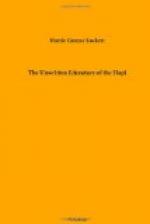When a snake is found under a bush or in his hole, the digging stick soon brings him within reach of the fearless hand; then sprinkling a pinch of corn meal on his snakeship and uttering a charm and prayer, the priest siezes the snake easily a few inches back of the head and deposits him in the pouch. Should the snake coil to strike, the snake whip (two eagle feathers secured to a short stick) is gently used to induce him to straighten out.
At sunset they return in the same grim formation, bearing the snake pouches to the kiva, where four jars (not at all different from their water jars) stand ready to receive the snakes and hold them till the final or ninth day of the ceremony.
On the next three mornings, just before dawn, in the Antelope Kiva, is held the symbolic marriage of Tiyo and the Snake Maiden, followed by the singing of sixteen traditional songs.
Just before sunset of the eighth day, the Antelope and Snake priests give a public pageant in the plaza, known as the Antelope or Corn Dance. It is a replica of the Snake Dance, but shorter and simpler, and here corn is carried instead of snakes.
On the morning of the ninth and last day occurs the Sunrise Corn Race, when the young men of the village race from a distant spring to the mesa top. The whole village turns out to watch from the rim of the mesa, and great merriment attends the arrival of the racers, the winner receiving some ceremonial object, which, placed in his corn field, should work as a charm and insure a bumper crop.
In 1912, Dr. Byron Cummings witnessed a more interesting sunrise race than the writer has ever seen or heard described by any other observer.
An aged priest stood on the edge of the mesa, before the assembled crowd of natives and visitors, and gave a long reverberating call, apparently the signal for which the racers were waiting, for away across the plain below and to the right was heard an answering call, and from the left and far away, another answer. Eagerly the crowd watched to catch the first glimpse of the approaching racers, for there was no one in sight for some time, from the direction of either of the answering calls.
Finally mere specks in the distance to the right resolved themselves into a line of six men running toward the mesa. As they came within hailing distance they were greeted by the acclamations of the watchers.
These runners were Snake priests, all elderly men, and as each in turn reached the position of the aged priest at the mesa edge, he received from that dignitary a sprinkling of sacred meal and a formal benediction, then passed on to the Snake Kiva.
Before the last of these had appeared, began the arrival of the young athletes from across the plain to the left. Swiftly them came, and gracefully, their lithe brown bodies glistening in the early sunlight, across the level lowland, then up the steep trail, to be met at the mesa edge by a picturesque individual carrying a cow bell and wearing a beautiful garland of fresh yellow squash blossoms over his smooth flowing, black hair, and a girdle of the same lovely flowers round his waist, with a perfect blossom over each ear completing his unique decoration.




